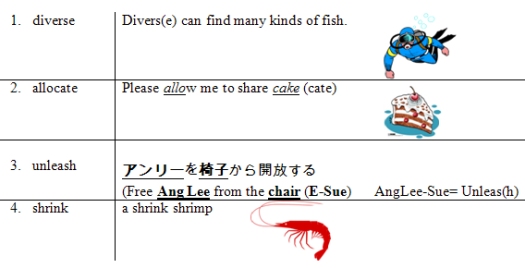Application of Word Link Memory Technique in the EFL/ESL Classroom
Michael Okamoto, Japan
Michael Okamoto is a university EFL instructor in Japan. He is interested in bilingual education and materials development for the EFL classroom.
E-mail: mjokamoto@gmail.com
Menu
Introduction
Application of this technique: vocabulary dictionary
Conclusions
References
A student’s time in university should be spent in pursuit in those interests that are academically stimulating while engaging the learner in a variety fields that assist in developing a well-rounded, global-ready citizen. It is this author’s opinion that too much of students’ time is spent putting new information to memory and not contributing toward the furthering of their particular field. Gardner (2000) states that “Schooling should be to develop intelligences and to help people reach vocational and avocational goals that are appropriate to their particular spectrum of intelligences. People who are helped to do so, feel more engaged and competent and therefore more inclined to serve society in a constructive way.” Willis (2008) also states that by using multiple learning techniques, learners store knowledge in multiple areas of the brain and that this “cross-referencing of data means we have learned, rather than just memorized”.
There have been many studies like the research performed by Paul W. Foos and Paula Goolkasian (2005) showing that people do remember pictures more easily than remember words. By attaching a meaningful image to each item to be learned, learners will be able to better retain and recall their meanings. Creativity is very important when incorporating this technique. Generally speaking, the crazier and more unique the image, the easier it is to later recall.
This article’s goal is to briefly introduce the Word Link memorization technique. Afterwards, the article will then provide an example of how this technique can be applied in the ESL/EFL classroom. The Word Link technique works by relating the meaning of an assigned vocabulary word in a creative sentence.
Example: The Spanish word “caber” means “to fit”

“It is barely possible to fit a bear into a cab”
(Image from: http://fourhourworkweek.com/2014/03/21/how-to-learn-a-foreign-language-2/)
By creating an image based on the meaning of the target word, the learner can later better recall the word itself with its correct meaning and pronunciation
In a recent TOEFL course, each student was asked to apply this memorization technique to a unique set of 30 vocabulary words. These sets were then brought together to create a vocabulary dictionary for the whole class to use as study tool. The students were asked to use the technique to create sentences and pictures that would help illustrate the meaning of each word.
Students were allowed to incorporate the technique in any manner that they felt appropriate. By allowing this independence, students were able to produce a variety of word images in both English and their L1 (Japanese) that contributed to some very creative responses.
Below are examples of the assigned words followed by the student created responses.

As can be seen in the examples provided, there is a variety of styles and ways that this technique can be applied to create meaningful images from the assigned vocabulary.
- Example #1- the student uses a similar sounding noun to explain the meaning.
- Example #2- the assigned word is split by its syllables in a sentence that possesses a similar meaning.
- Example #3- the learner created a sentence in their L1 that explained the meaning of the assigned word but with words that sound similar to the assigned vocabulary.
- Example #4- the sentence contains a grammatical error, however the meaning and imagery are still properly expressed.
By being allowed a great level of creative freedom students not only participate in the learning process and thusly become more motivated, but the created images allow for better recall in the long term. (Foos, P.W., & Goolkasian, P.)
Please consider using this activity in your classes whenever introducing new vocabulary words. The responses I have received have been very positive and am confident that your experience will be similar.
Foos, P.W., & Goolkasian, P. (2005). Presentation formats in working memory: The role of attention. Memory & Cognition, 33(3), 499-513.
Gardner, Howard (2000), Intelligence Reframed: Multiple Intelligences for the 21st Century. Basic Books. p.30-34.
Willis, J. (2008). Brain-based teaching strategies for improving students' memory, learning, and test-taking success. Childhood Education, 83(5), p.31-36. See:
www.llu.edu/medicine/medical-student-education/resources/

Please check the Creative Methodology for the Classroom course at Pilgrims website.
Please check the CLIL: Content and Methodology for Secondary Teachers course at Pilgrims website.
Please check the Practical Uses of Technology in the Classroom course at Pilgrims website.


|